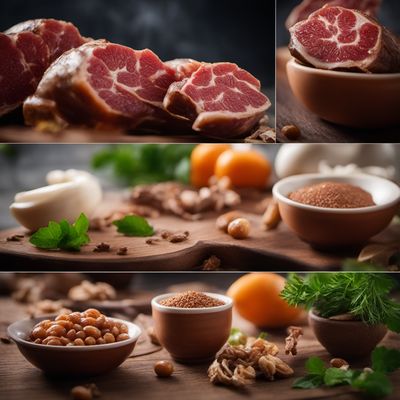
Ingredient
Sheep carcase
The Art of Lamb: Exploring the Versatility of Sheep Carcass
Sheep carcase is characterized by its tender, juicy meat that is full of flavor. The meat is typically pinkish-red in color, with a fine texture and a moderate amount of fat marbling. When cooked, it becomes incredibly tender and develops a rich, savory taste. Whether roasted, braised, or grilled, sheep carcase is a versatile ingredient that can be prepared in various ways to create mouthwatering dishes.
Origins and history
Sheep carcase has a long history dating back thousands of years. It has been a staple in many cultures, including Mediterranean, Middle Eastern, and Asian cuisines. Sheep farming has been practiced for centuries, with different breeds and husbandry techniques contributing to the unique flavors and characteristics of sheep carcase. The meat's popularity can be attributed to its versatility and ability to complement a wide range of flavors and ingredients.
Nutritional information
Sheep carcase is a good source of high-quality protein, essential vitamins such as B12 and niacin, and minerals like iron and zinc. It is also relatively low in calories and saturated fat compared to other meats, making it a nutritious choice for a balanced diet.
Allergens
None known.
How to select
When selecting sheep carcase, look for cuts that have a bright, pinkish-red color and firm, evenly distributed fat. The meat should feel firm to the touch and have a fresh, clean smell. Avoid cuts that appear discolored, have a strong odor, or feel slimy to the touch.
Storage recommendations
To maintain the freshness and quality of sheep carcase, it is best to store it in the refrigerator at a temperature below 40°F (4°C). If the meat will not be used within a few days, it can be stored in the freezer for longer-term storage. Proper packaging, such as wrapping the meat tightly in plastic wrap or placing it in airtight containers, will help prevent freezer burn and maintain its flavor.
How to produce
Sheep carcase can be produced by raising sheep on a farm or through specialized livestock production. It requires proper animal husbandry practices, including providing adequate nutrition, shelter, and veterinary care. Raising sheep for meat production involves managing their diet, ensuring they have access to clean water, and providing a suitable environment for their growth and development.
Preparation tips
Sheep carcase can be prepared in various ways, depending on the desired dish. For roasting, season the meat with herbs, spices, and garlic, and cook it in a preheated oven until it reaches the desired doneness. For stews and braises, cut the meat into smaller pieces and simmer it slowly with vegetables, broth, and aromatic ingredients for a rich and flavorful dish. Grilling or barbecuing sheep carcase can also result in deliciously charred and smoky flavors. Remember to let the meat rest before slicing to allow the juices to redistribute and ensure maximum tenderness.
Substitutions
Beef carcase can be used as a substitute for sheep carcase, although the flavor and texture will differ slightly. Alternatively, other cuts of lamb, such as leg or shoulder, can be used in recipes that call for sheep carcase.
Culinary uses
Sheep carcase is commonly used in a variety of dishes and cuisines around the world. It is often roasted whole or cut into chops or racks for elegant and flavorful main courses. The meat can also be used in stews, curries, kebabs, and sausages, adding depth and richness to these dishes. In Mediterranean and Middle Eastern cuisines, sheep carcase is frequently used in traditional dishes like lamb tagine, moussaka, and shepherd's pie.
Availability
Sheep carcase is commonly available in regions with a strong tradition of sheep farming, such as Australia, New Zealand, the United Kingdom, and various countries in the Middle East and Mediterranean. It is also cultivated and consumed in parts of North America, South America, and Asia.
More ingredients from this category » Browse all

Goat carcase
The Wholesome Base

Rabbit carcase
The Art of Rabbit: Unlocking the Culinary Potential of Rabbit Carcass

Deer carcase
Venison: The Wild Delicacy

Pig carcase
Pig Carcase: A Versatile Ingredient

Goose carcase
The Flavorful Foundation

Wild boar carcase
Untamed Bounty: Wild Boar

Horse carcase
The Noble Beast: Horse Meat

Bovine carcase
The Foundation of Flavor

Ratites carcase
The Exotic Delicacy: Ratites Carcase Unveiled

Asses-mules-hinnies carcase
The Forgotten Meat

Turkey carcase
The Versatile Turkey Carcase

Duck carcase
The Essence of Duck: Unveiling the Secrets of Duck Carcase